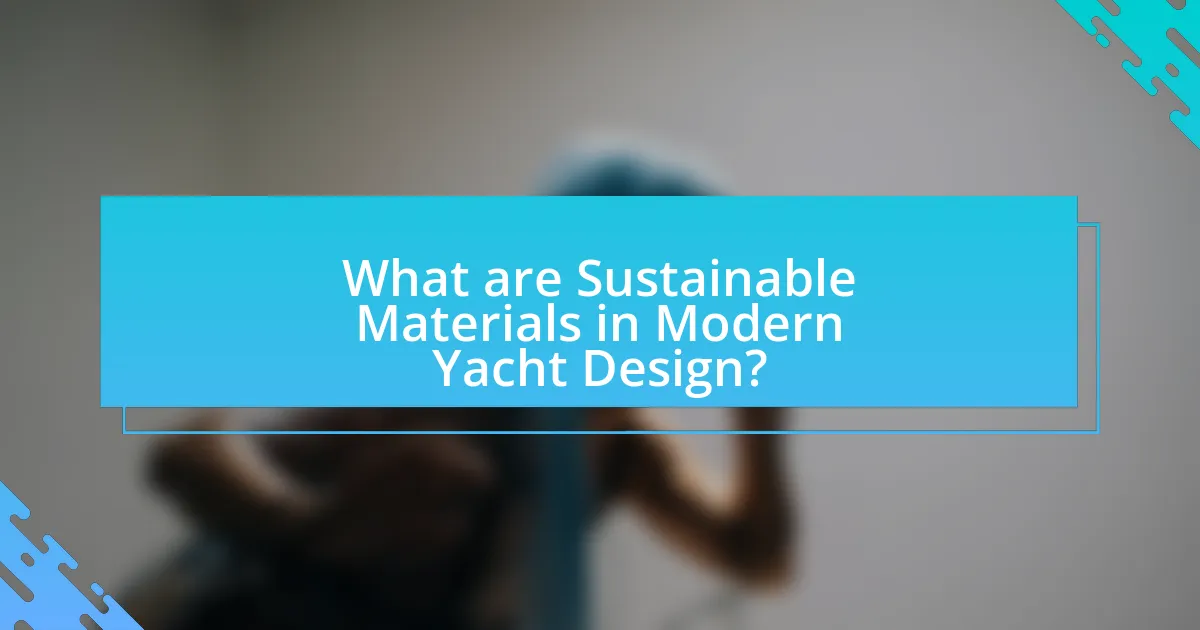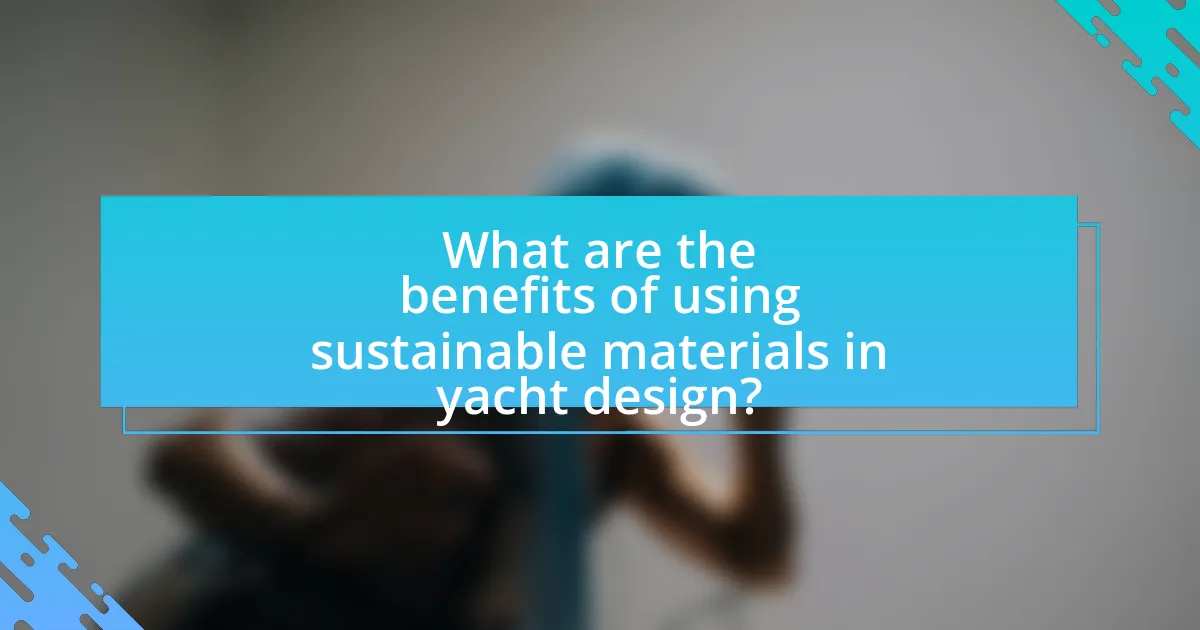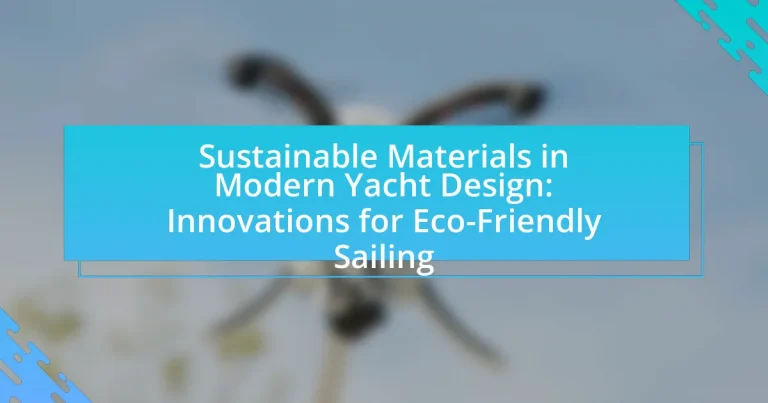Sustainable materials in modern yacht design encompass eco-friendly resources that reduce environmental impact while ensuring performance and aesthetics. Key materials include recycled aluminum, sustainably sourced wood, and biocomposites, which collectively contribute to eco-friendly sailing by minimizing waste and carbon emissions. The article explores the benefits of these materials, their comparison to traditional yacht materials, and the innovations driving their adoption in the industry. It also addresses the importance of sustainability in yacht design, the challenges faced by designers, and the influence of consumer preferences on future trends in yacht construction.

What are Sustainable Materials in Modern Yacht Design?
Sustainable materials in modern yacht design refer to eco-friendly resources that minimize environmental impact while maintaining performance and aesthetics. These materials include recycled aluminum, which offers durability and lightweight properties, and sustainably sourced wood, such as teak from certified forests, which reduces deforestation. Additionally, biocomposites made from natural fibers and resins provide an alternative to traditional fiberglass, lowering carbon footprints. The use of these materials is supported by industry trends emphasizing sustainability, with a growing number of yacht manufacturers adopting eco-conscious practices to meet consumer demand for greener options.
How do sustainable materials contribute to eco-friendly sailing?
Sustainable materials contribute to eco-friendly sailing by reducing environmental impact through the use of renewable resources and minimizing waste. For instance, materials like bamboo, recycled plastics, and bio-based composites are increasingly utilized in yacht construction, which lowers carbon emissions associated with traditional materials. Research indicates that using bamboo can reduce the overall weight of the vessel, enhancing fuel efficiency and decreasing energy consumption during sailing. Additionally, the adoption of recycled materials in yacht design not only diverts waste from landfills but also lessens the demand for virgin resources, further promoting sustainability in the marine industry.
What types of sustainable materials are commonly used in yacht construction?
Sustainable materials commonly used in yacht construction include bamboo, recycled aluminum, and bio-resins. Bamboo is favored for its rapid growth and strength, making it an eco-friendly alternative to traditional hardwoods. Recycled aluminum is utilized for its lightweight properties and recyclability, reducing the environmental impact associated with mining new materials. Bio-resins, derived from natural sources, replace conventional petroleum-based resins, offering a lower carbon footprint and improved biodegradability. These materials contribute to the overall sustainability of yacht design by minimizing resource depletion and environmental harm.
How do these materials compare to traditional yacht materials?
Sustainable materials in modern yacht design, such as recycled plastics and bio-composites, offer significant advantages over traditional yacht materials like fiberglass and wood. These sustainable options are lighter, which enhances fuel efficiency and performance, and they often have a lower environmental impact due to reduced carbon footprints in their production processes. For instance, bio-composites can be made from renewable resources, while traditional materials often rely on non-renewable sources. Additionally, sustainable materials can provide improved durability and resistance to corrosion, which extends the lifespan of the yacht. Studies indicate that using recycled materials can reduce waste and promote circular economy practices within the marine industry, further validating the benefits of these innovative materials compared to conventional yacht construction methods.
Why is sustainability important in yacht design?
Sustainability is important in yacht design because it minimizes environmental impact while promoting resource efficiency. The yacht industry significantly contributes to marine pollution and carbon emissions; therefore, incorporating sustainable practices can reduce these negative effects. For instance, using eco-friendly materials, such as recycled composites and sustainably sourced wood, can lower the carbon footprint of yacht construction. Additionally, implementing energy-efficient technologies, like solar panels and hybrid propulsion systems, enhances fuel efficiency and reduces reliance on fossil fuels. These innovations not only align with global sustainability goals but also appeal to environmentally conscious consumers, driving market demand for greener yachts.
What environmental impacts are associated with traditional yacht materials?
Traditional yacht materials, such as fiberglass, wood, and metals, have significant environmental impacts. Fiberglass production involves the use of harmful chemicals and generates substantial waste, contributing to pollution and resource depletion. Wood sourcing can lead to deforestation and habitat destruction, particularly when unsustainable practices are employed. Additionally, metals like aluminum and steel require energy-intensive extraction and processing, resulting in high carbon emissions. According to a study by the International Maritime Organization, the maritime industry is responsible for approximately 2.5% of global greenhouse gas emissions, highlighting the broader implications of traditional yacht materials on climate change.
How does sustainable yacht design influence marine ecosystems?
Sustainable yacht design positively influences marine ecosystems by minimizing environmental impact through the use of eco-friendly materials and technologies. For instance, the incorporation of renewable resources, such as bamboo and recycled aluminum, reduces the carbon footprint associated with yacht construction. Additionally, sustainable designs often include energy-efficient systems, like solar panels and hybrid propulsion, which decrease reliance on fossil fuels, thereby lowering greenhouse gas emissions that can harm marine life. Research indicates that adopting sustainable practices in yacht design can lead to a significant reduction in pollution and habitat destruction, promoting healthier marine environments.
What innovations are driving the use of sustainable materials in yacht design?
Innovations driving the use of sustainable materials in yacht design include the development of bio-based composites, advanced recycling technologies, and the integration of renewable energy systems. Bio-based composites, made from natural fibers and resins, reduce reliance on petroleum-based materials and lower the carbon footprint of yacht construction. Advanced recycling technologies enable the repurposing of materials from decommissioned yachts, minimizing waste and promoting circular economy practices. Additionally, the integration of renewable energy systems, such as solar panels and wind turbines, enhances energy efficiency and reduces the environmental impact of yacht operations. These innovations collectively contribute to a more sustainable approach in yacht design, aligning with the growing demand for eco-friendly solutions in the maritime industry.
How are advancements in technology enhancing sustainable material options?
Advancements in technology are enhancing sustainable material options by enabling the development of innovative, eco-friendly materials that reduce environmental impact. For instance, the use of bio-based composites, which incorporate natural fibers and resins, has increased due to improved manufacturing techniques that enhance their strength and durability. Additionally, advancements in recycling technologies allow for the efficient repurposing of materials, such as recycled plastics and metals, into high-performance components for yacht construction. Research indicates that these materials can significantly lower carbon footprints; for example, a study by the University of Cambridge found that bio-composites can reduce greenhouse gas emissions by up to 50% compared to traditional materials. Thus, technological progress is crucial in providing sustainable alternatives that meet the demands of modern yacht design while promoting environmental stewardship.
What role do designers play in promoting sustainable practices?
Designers play a crucial role in promoting sustainable practices by integrating eco-friendly materials and innovative design techniques into their projects. In the context of yacht design, they prioritize the use of sustainable materials such as recycled composites and responsibly sourced wood, which reduce environmental impact. For instance, the adoption of bio-based resins in yacht construction can significantly lower carbon emissions compared to traditional materials. Furthermore, designers implement energy-efficient systems and optimize hull shapes to enhance fuel efficiency, thereby minimizing resource consumption during operation. This commitment to sustainability not only addresses environmental concerns but also meets the growing demand for eco-conscious products among consumers.
How can yacht builders implement sustainable materials effectively?
Yacht builders can implement sustainable materials effectively by integrating renewable resources, such as bamboo and recycled plastics, into their construction processes. Utilizing bamboo, which grows rapidly and absorbs carbon dioxide, provides a strong yet lightweight alternative to traditional woods. Additionally, incorporating recycled plastics not only reduces waste but also minimizes the environmental impact associated with new material production. Research indicates that using recycled materials can lower the carbon footprint of yacht manufacturing by up to 30%, demonstrating a significant environmental benefit. By prioritizing these sustainable materials, yacht builders can enhance eco-friendliness while maintaining performance and durability in their designs.
What challenges do designers face when using sustainable materials?
Designers face several challenges when using sustainable materials, including limited availability, higher costs, and performance issues. The limited availability of sustainable materials can restrict designers’ options, making it difficult to source the right materials for specific applications in yacht design. Higher costs associated with sustainable materials often arise from the production processes and sourcing practices, which can exceed traditional materials, impacting overall project budgets. Additionally, performance issues may occur, as some sustainable materials may not meet the same durability or aesthetic standards as conventional materials, leading to potential compromises in design and functionality. These challenges necessitate careful consideration and innovation in material selection to achieve eco-friendly sailing solutions.

What are the benefits of using sustainable materials in yacht design?
Using sustainable materials in yacht design offers significant environmental benefits, including reduced carbon footprint and minimized resource depletion. Sustainable materials, such as bamboo, recycled aluminum, and bio-resins, contribute to lower greenhouse gas emissions during production and disposal compared to traditional materials. For instance, the use of recycled aluminum can save up to 95% of the energy required to produce new aluminum, thereby significantly lowering overall energy consumption. Additionally, sustainable materials often promote biodiversity by reducing the demand for virgin resources, which can lead to habitat destruction. By integrating these materials, yacht designers not only enhance the ecological integrity of their vessels but also appeal to a growing market of environmentally conscious consumers.
How do sustainable materials enhance yacht performance?
Sustainable materials enhance yacht performance by reducing weight and improving structural integrity. For instance, materials like bamboo and recycled composites are lighter than traditional materials, which leads to increased speed and fuel efficiency. Additionally, these materials often possess superior strength-to-weight ratios, allowing for more efficient hull designs that can withstand harsh marine conditions. Research indicates that using sustainable materials can lead to a reduction in carbon emissions by up to 30% during production and operation, further supporting their role in enhancing overall yacht performance.
What are the long-term cost benefits of using sustainable materials?
The long-term cost benefits of using sustainable materials in yacht design include reduced maintenance costs, lower energy consumption, and enhanced resale value. Sustainable materials, such as bamboo and recycled composites, often require less upkeep due to their durability and resistance to environmental damage, leading to significant savings over time. Additionally, yachts constructed with energy-efficient materials can lower operational costs by reducing fuel consumption, as these materials often contribute to lighter and more efficient designs. Research indicates that eco-friendly yachts can retain higher resale values, as consumer demand for sustainable options increases, making them a financially sound investment in the long run.
How do sustainable materials improve the overall aesthetic of yachts?
Sustainable materials enhance the overall aesthetic of yachts by offering unique textures, colors, and finishes that are often more visually appealing than traditional materials. For instance, bamboo and reclaimed wood provide a warm, organic look that resonates with nature, while recycled metals can be polished to create a sleek, modern appearance. Additionally, the use of eco-friendly composites allows for innovative design shapes and lightweight structures, contributing to a more streamlined and elegant yacht profile. Research indicates that yachts built with sustainable materials not only attract environmentally conscious buyers but also elevate the perceived luxury and craftsmanship of the vessel, as seen in the growing trend of eco-luxury yacht design.
What are the social implications of sustainable yacht design?
Sustainable yacht design has significant social implications, primarily by promoting environmental awareness and influencing consumer behavior. This design approach encourages yacht owners and manufacturers to prioritize eco-friendly materials and practices, which can lead to a broader societal shift towards sustainability in various industries. For instance, the use of renewable resources and energy-efficient technologies in yacht construction can inspire similar practices in other sectors, fostering a culture of environmental responsibility. Additionally, sustainable yacht design can enhance community engagement by supporting local economies through the use of regional materials and labor, thereby creating jobs and promoting social equity. Studies indicate that environmentally conscious consumers are more likely to support brands that demonstrate sustainability, which can drive market demand for eco-friendly products across the board.
How does sustainable yacht design influence consumer choices?
Sustainable yacht design significantly influences consumer choices by aligning with the growing demand for environmentally responsible products. Consumers increasingly prioritize sustainability, leading to a preference for yachts that utilize eco-friendly materials and technologies, such as solar panels and energy-efficient engines. A study by the International Council on Clean Transportation found that 70% of luxury yacht buyers consider environmental impact a critical factor in their purchasing decisions. This trend indicates that sustainable design not only enhances the appeal of yachts but also drives market competitiveness, as brands that adopt sustainable practices can attract a more conscientious consumer base.
What role does community engagement play in promoting sustainable practices?
Community engagement plays a crucial role in promoting sustainable practices by fostering collaboration and awareness among individuals and organizations. Engaged communities are more likely to adopt eco-friendly behaviors, as they share knowledge and resources, leading to collective action towards sustainability. For instance, initiatives like community clean-up events or local sustainability workshops have been shown to increase participation in recycling and conservation efforts. Research indicates that communities with strong engagement in sustainability initiatives see a 30% increase in participation in eco-friendly practices compared to less engaged communities. This demonstrates that active involvement not only raises awareness but also drives tangible changes in behavior towards sustainability.

What future trends can we expect in sustainable yacht design?
Future trends in sustainable yacht design will focus on the integration of renewable energy sources, advanced eco-friendly materials, and innovative waste management systems. The use of solar panels and wind turbines is expected to become standard, significantly reducing reliance on fossil fuels. Additionally, materials such as recycled aluminum, bio-based composites, and sustainably sourced wood will gain prominence, enhancing the environmental performance of yachts. Research indicates that the yacht industry is increasingly adopting circular economy principles, aiming to minimize waste and maximize resource efficiency throughout the lifecycle of the vessel. These trends reflect a growing commitment to sustainability within the maritime sector, driven by both regulatory pressures and consumer demand for greener options.
How is the industry adapting to changing regulations regarding sustainability?
The industry is adapting to changing regulations regarding sustainability by integrating eco-friendly materials and practices into yacht design. Manufacturers are increasingly utilizing sustainable materials such as recycled aluminum, bio-based composites, and responsibly sourced wood to comply with stricter environmental standards. For instance, the International Maritime Organization has set guidelines that encourage the reduction of greenhouse gas emissions, prompting yacht builders to innovate with energy-efficient technologies and sustainable production methods. This shift not only meets regulatory requirements but also appeals to environmentally conscious consumers, demonstrating a commitment to sustainability in modern yacht design.
What innovations are on the horizon for sustainable yacht materials?
Innovations on the horizon for sustainable yacht materials include the development of bio-based composites, recycled plastics, and advanced natural fibers. Bio-based composites, made from renewable resources like hemp and flax, offer lightweight and durable alternatives to traditional materials. Recycled plastics are being repurposed into structural components, reducing waste and environmental impact. Additionally, advancements in natural fibers, such as mycelium and bamboo, are being explored for their strength and sustainability. These innovations are supported by industry trends emphasizing eco-friendly practices and regulatory pressures for greener manufacturing processes.
How might consumer preferences shape the future of yacht design?
Consumer preferences will significantly shape the future of yacht design by driving demand for sustainable materials and eco-friendly innovations. As awareness of environmental issues increases, consumers are increasingly favoring yachts that utilize renewable resources, such as bamboo and recycled plastics, which reduces the ecological footprint of manufacturing. According to a 2021 report by the International Council on Clean Transportation, the marine industry is projected to see a 30% increase in demand for sustainable vessels by 2025, indicating a clear shift in consumer priorities. This trend compels yacht manufacturers to innovate and adapt their designs to meet these preferences, ensuring that future yachts are not only luxurious but also environmentally responsible.
What practical tips can yacht owners follow to support sustainable practices?
Yacht owners can support sustainable practices by implementing energy-efficient technologies, such as solar panels and wind turbines, to reduce reliance on fossil fuels. These technologies can significantly lower carbon emissions, with solar panels capable of providing up to 80% of a yacht’s energy needs, depending on size and usage. Additionally, yacht owners should choose eco-friendly materials for maintenance and upgrades, such as biodegradable cleaning products and sustainably sourced wood, which minimizes environmental impact. Regular maintenance of engines and systems also ensures optimal performance and reduces waste, contributing to sustainability. Furthermore, participating in marine conservation programs and adhering to local regulations can enhance efforts to protect marine ecosystems.

















